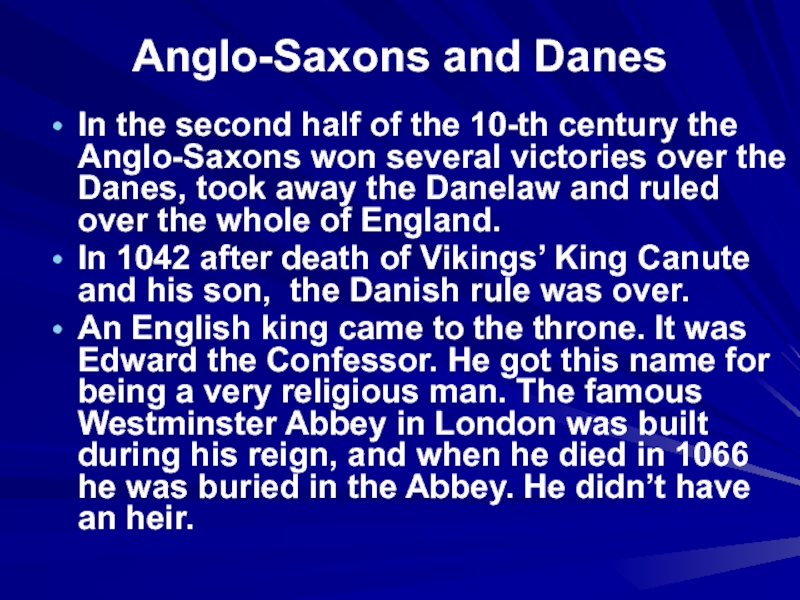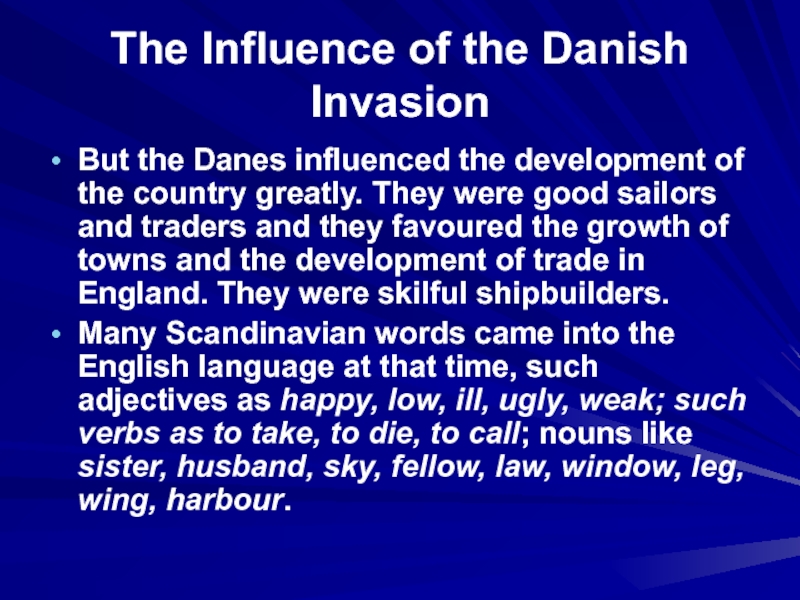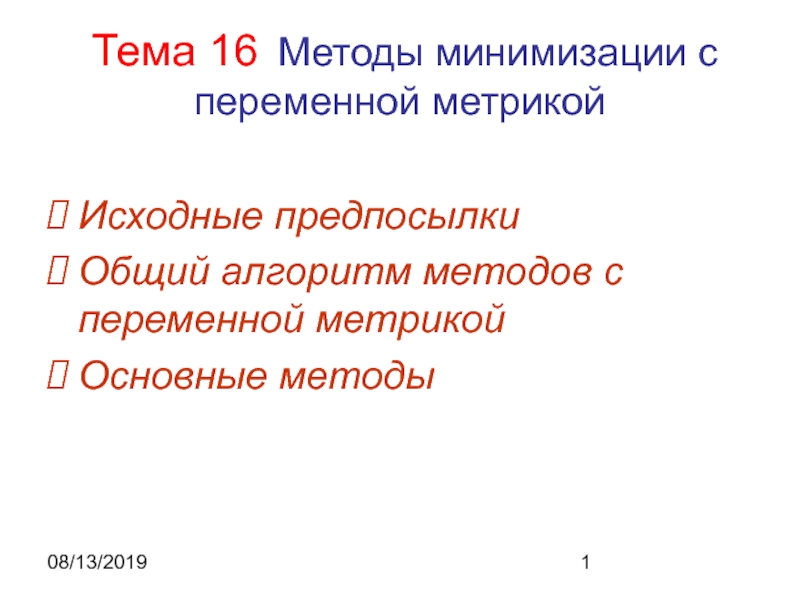Слайд 1HISTORICAL BACKGROUND
OF THE UK
Scandinavian Invasion
Abrossimova L.S.
Слайд 2Barbarians
From the end of the 8-th century and during the
9-th and 10-th centuries Western Europe was troubled by a
new wave of barbarian attacks.
These barbarians came from the North - from Norway, Sweden and Denmark, and were called Northmen. In different countries the Northmen were known as the Vikings, the Normans, the Danes.
More often the British Isles were raided from Denmark, and the invaders came to be known in English history as the Danes.
The Danes were of the same Germanic race as the Anglo-Saxons themselves.
The Danes were well-armed with swords, spears bottle-axes. They were bold and skilful men.
Слайд 4Danish Raids
In 793 the Danes carried out their first
raids on Britain. In later years large Danish fleets (more
than 300 ships) brought large armies to conquer and settle in the new lands. Thus began the fourth conquest of Britain.
The Danish raids were successful because the kingdom of England had neither a regular army nor a fleet in the North Sea to meet them.
Слайд 5Danish Raids
Northumbria and East Anglia suffered most from the Danish
raids. At last all England north of the Thames was
in their hands. Only Wessex was left to face the enemy.
In 835 King Egbert defeated them. In 871 The Danes invaded Wessex again. Then Wessex united the small Anglo-Saxon kingdoms and under the reign of Egbert's grandson, King Alfred (871-899) who became known in English history as Alfred the Great, Wessex became the centre of resistance against the invaders.
Слайд 6King Alfred the Great
Alfred, the grandson of Egbert, became
king in the year 871, when England’s danger was greatest.
Danes continued robbing and killing the people of England . Alfred gathered a big army and gave the Danes a great battle at Maldon in 891.
Слайд 8King Alfred
the Great
Alfred was the only king of England,
who got the name “the Great”. He was very well
educated for his time. He had leaned to read and write when he was quite young. He had travelled to the continent and visited France. He is famous not only for having built the first navy, but also for having tried to educate his people.
Слайд 9King Alfred the Great
During the reign of King Alfred
the Great builders and scholars were invited from the Continent.
The monasteries and Churches which had been burnt by the Danes were rebuilt and schools were set up in the monasteries.
King Alfred demanded that all the priests and state officials should learn Latin. Some books were translated from Latin by King Alfred himself. Among others he translated Ecclesiastical History of the English People.
Alfred ordered that the learned men should begin to write a history of England. Thus was written a history of England called the Anglo-Saxon Chronicle which was continued for 250 years after the death of Alfred by monks. The Anglo-Saxon Chronicle is on view now at the British Museum.
Слайд 10Anglo-Saxons and Danes
The Anglo-Saxons won several victories over the Danes.
The Danes settled in the north-eastern part of England, a
region which was from that time called the Danelaw, because it was ruled according to the law of the Danes.
The Anglo-Saxon kings that ruled after Alfred the Great, continued fighting the Danes, until all England was once more ruled by English kings.
But 80 years after Alfred’s death the Danes came again with great armies and occupied much of the territory.
Слайд 11Anglo-Saxons and Danes
In the second half of the 10-th century
the Anglo-Saxons won several victories over the Danes, took away
the Danelaw and ruled over the whole of England.
In 1042 after death of Vikings’ King Canute and his son, the Danish rule was over.
An English king came to the throne. It was Edward the Confessor. He got this name for being a very religious man. The famous Westminster Abbey in London was built during his reign, and when he died in 1066 he was buried in the Abbey. He didn’t have an heir.
Слайд 12 The dispute for the English throne began.
It
was between Harold Godwin and Norman Duke William
The dispute led
to the Norman Conquest of 1066
Слайд 13The Influence of the Danish Invasion
But the Danes influenced
the development of the country greatly. They were good sailors
and traders and they favoured the growth of towns and the development of trade in England. They were skilful shipbuilders.
Many Scandinavian words came into the English language at that time, such adjectives as happy, low, ill, ugly, weak; such verbs as to take, to die, to call; nouns like sister, husband, sky, fellow, law, window, leg, wing, harbour.
Слайд 14Anglo-Saxon Literature
Anglo-Saxon Literature - the literary writings in Old English,
composed between 650 and 1100
Old English literary works include
genres such as epic poetry, hagiography, sermons, Bible translations, legal works, chronicles, riddles, and others. In all there are about 400 surviving manuscripts from the period.
The most famous works from this period include:
the poem Beowulf, which has achieved national epic status in Britain;
The Anglo-Saxon Chronicle is a collection of important early English history.
Cædmon's Hymn from the 7th century is the earliest attested literary text in English.


































